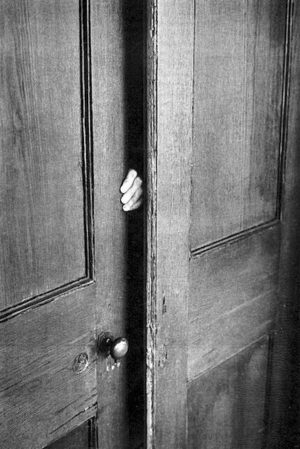
“Capital Journal collecting sir.”
He just looked at me through his screened front door with a look on his face that was a mix of astonishment, shock, and concern. I suppose that would be the normal reaction upon seeing a young 11-year-old boy, with a dog hanging silently from his arm, attempting to be completely professional in collecting the newspaper’s monthly bill.
The Dog
When I took over my paper route, there was this one house, a small cape cod that had a fence overrun by weeds containing the front yard, that I just didn’t like delivering to. There was always a yippy little dog in the front, and it went berserk whenever I delivered the old man’s paper every afternoon. Too be honest, its attempts to jump the fence or dig under it scared me. He obviously was out to murder me if he could. He would show no mercy, I assumed, if he got me.
To make matters worse, sometimes the old man would be out on his porch seeing and hearing all this commotion and would just look at me with an odd stare – looking straight through me. At times it appeared that he was laughing as he sat there in his jeans and white tank top shirt watching his dog salivate and snarl at me as he sipped on his beer. What if he had trained the dog to be this nasty? What if he was the author of the master plan to maim me for life? And worse yet, what if the dog did get me?
Monthly I had to collect the newspaper’s bill from all my customers, including this old, possibly malicious man. I didn’t want to do it. I was scared that his dog would bite me, and I would end up without fingers, or would come away with one less eye, or be scarred permanently and never have the opportunity to have a real date with…a girl…not that I liked girls then. I’m just saying’.
The fear was real. The threat was real. And the consequences were severe, if, if it happened. So, what do you when you’re 11 and don’t know what to do? For me, I told my dad.
My Ride with Dad
The next day Dad accompanied me on my route following behind me on his bicycle as I moved steadily through my assigned streets. After awhile he rode up next to me and complimented me on my ability to ride, fold, and get the papers into the paper box without stopping. He was impressed by my skills and confidence. We had a good talk. It was a blast.
Suddenly, things changed as the cape cod house came into view. I slowed and became a little bit erratic on the bike. It was obvious that my fear was impacting my confidence. I could tell dad saw the impact the house had on me as well. “Is that the house, son?” he asked.
“Yes sir.” I said.
“I’m gonna stop when we get near and I want to watch what happens when you do your normal thing,” he responded.
I said, “….uuuuuh, Ok”
At that point I was on my own again. And it played out just as it always did. The dog was losing its marbles again. And I was acting fearful and not in my normal smooth deliberate delivery. At least dad saw it. And now he knew the tomfoolery that I had to deal with every day.
Dad surprised me though. He didn’t stop and go confront the dog or old man. He just said that we should just keep going like nothing happened and finish the route. He told me we should both think on what happened today and come up with a plan of action later. I was quiet and just nodded my head. I suppose he had a reason to not take on these newspaper route demons now, but I didn’t know what it was.
The Lesson
Later, dad and I discussed what had happened. He said this, “Son, there is a difference in how we see “what if?” when we understand the real risk associated with it vs. when we don’t know the risk. Many “what ifs” are questions that often are not answerable or not worth the effort to answer. These types of “what ifs” are expressions of fear about a possibility without any understanding of the risk or likelihood of that awful event occurring. For example, think of this: what if the sun stops shining tomorrow? Yes, we will die. But the likelihood of that happening is near zero. There is very little risk that the sun will stop shining tomorrow. The “what ifs” where the risk is unknown paralyze us and make it difficult to move forward. They make us afraid.” But if we know the risk, and it’s very low, we may not have any fear at all.
He continued, “Let’s apply this to the dog. If the dog is in the yard going crazy because of your presence, what is the likelihood that it will be able to jump out?
I said, “well I don’t know, but it sure tries.”
Dad asked again, ‘how likely? Has it ever even got close?
“No” I said.
“So, there really isn’t any “real” thing here to be afraid of; you’re afraid of a “what if”,” Dad stated.
“Yes, I suppose I am. Hmmmm…you’re saying I’ve been afraid of something that can’t happen. Wow, I hadn’t thought of it like that,” I said feeling liberated once I got what he was talking about.
“So son, if you needed to collect from the old man, what is the likelihood that dog would attack you if you went through the gate in the fence?”
I said, “I think he would get me dad, not doubt”.
“OK, so the “what if” risk regarding getting into the yard with the dog is pretty high – you would get attacked?”
“Yeh,” I said.
“So, what could we do to ensure that when you are in the yard that you don’t get attacked?” he asked.
I said, “shoot it?”
He just grimaced and asked, “come on, what could you do?
I had to think about that for a bit. Finally, I said, “well, if the dog was tied up so it couldn’t get me when I go to the door, that would work. Or, if the dog was in the house or backyard, it wouldn’t be able to get me either.” I said.
Dad replied, “Good ideas. Now, how could you make that happen?”
The Plan
Here’s the plan I came up with: I will put a letter in the old man’s newspaper one day and spell out my fear and the real risk I faced when it was time to collect. And I will ask the old man to help me by suggesting he use the tactics that Dad and I had discussed.
Interesting, after stuffing my note in his paper, the next day he was watching for me and came out when I approached his house. He apologized for the behavior of his dog and said that he would ensure that I’d be OK next time I had to collect. That blew me away, I thought he was the devil’s evil twin. So, we agreed that I would leave a note in his paper the day before I was going to collect, and he would either tie the dog up or have it in the house. And he told me that if saw the dog in the front not tied up, I should not collect. And if I saw the dog tied up or didn’t see it in the front yard, then it would be safe to collect. That worked for me.
Ouch
For several months this worked like a charm. And, as time progressed, I was pretty much over my irrational fear, my fear of a “what if” that couldn’t really happen. Our procedure was working well. Everything was clicking until…
…He stood there seeing his dog weirdly hanging from my arm – just hanging, noiselessly and calmly. I could see the tears that were trying to hang from his eyes begin to roll down his rough unshaven cheeks. He, I believe, felt more pain and angst than I. I hadn’t seen the dog behind the bushes doing its duty. I hadn’t really looked that hard either because everything had been working so well. I didn’t see the dog until it was hanging from my arm making its indelible scars on my skin and psyche. They are still there today. In the end, I had forgotten about the risk, albeit low, of being in the yard.
However, not all was lost – the event had its good things too. First, the dog apparently had no desire to maim me; it just wanted to hang from my arm. Second, it was the beginning of a friendship with that old man that lasted for many years beyond my years as a paperboy. He was wise, he was alone, he had fought bravely in WW2, and he was a wounded soul. I realized after a while that I was helping him fight to get home from a war that had long passed through a few words or unspoken smiles that he had avoided for so long.
And it added a new wrinkle to “what if…” I learned that fear can be managed by approaching it rationally, by understanding the risk associated with the “what if?”. I had discovered that you can consciously reduce the risk by doing things that make the terrifying “what if” event less likely to occur. And if it still occurs, even though the probability is lower, you can improve the mitigation efforts to make it even less likely to occur if you think hard enough. Everything is improvable. You can mitigate the risk on most “what ifs.” (By the way, in our case we created a new procedure that used red and green cards to communicate whether it was OK to collect or not).
The What If Paradox
It hurt that day, that dog hanging from my arm. And the pain highlights the paradox of “what if?” “What if?” allows us to move forward, to dream and soar. And “what if?” can also nail our feet to the floor preventing us from moving forward. It incapacitates us when associated with our fear of the bad outcome that is driven by the irrational feelings that come from not knowing the probability that the feared event can occur.
Think of the companies that have dreamed big after asking “What if?” and dissected the risk associated with that dream. When they understood the risk, they freed themselves from the chains that prevented them from moving forward. Microsoft, Federal Express, Netflix, and others come to mind. Think of the people who asked, “what if?”, assessed the risk, and moved forward. These people come to mind: Dwight Eisenhower the months and weeks for the WW2 D-Day event, the Catholic Democrat John Kennedy who moved America to go to the moon, and Martin Luther King who saw the liberation of the black man as possible if violence was not the means to an end.
The “what if” question moves mountains. And the “what it” question can make the desire to climb the mountain paralyzing. We all attempt to avoid the pain, but we cannot allow ourselves to be stopped by our ignorance of the likelihood that the pain can occur – that is irrational. It is the nature of “What if…?”
About Donald Kerper
Donald Kerper is an Industrial – Organizational Psychology practitioner who helps management teams determine their strategic pathway, assists them develop the leadership capability to execute their strategy, and supports their efforts to engage their employees in improvement of their business processes.
Kerper is always available for a free complimentary call to discuss your needs whether it be executive coaching or facilitating a major organization change initiative. Schedule a free call today and let us help you achieve your goals and objectives successfully. Imagine, “what if…?”


0 Comments